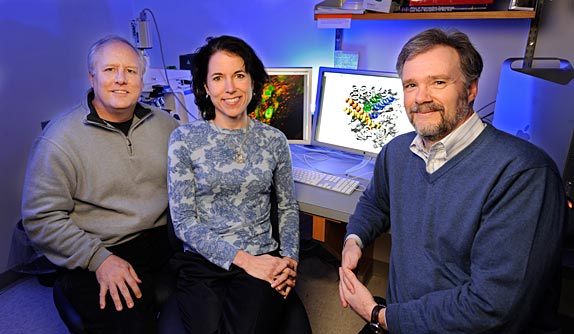
The most widely prescribed antidepressants – medicines such as Prozac, Lexapro and Paxil – work by blocking the serotonin transporter, a brain protein that normally clears away the mood-regulating chemical serotonin. Or so the current thinking goes.
That theory about how selective serotonin reuptake inhibitors (SSRIs) work can now be put to the test with a new mouse model developed by neuroscientists at Vanderbilt University.
These mice, described in the online edition of the Proceedings of the National Academy of Sciences (PNAS), express a serotonin transporter that has been genetically altered so that it does not respond to many SSRIs or cocaine.
In addition to testing the theory about how SSRIs work, the new mouse model could lead to the development of entirely new classes of anti-depressant medications, said Randy Blakely, Allan D. Bass Professor of Pharmacology and Psychiatry at Vanderbilt and senior author of the PNAS paper.
“Many antidepressants have been shown to target other proteins besides the serotonin transporter and . . . their efficacy in treating depression takes many weeks to develop,” Blakely said. “There is likely a lot that we don’t know about how these drugs act.”
Creating the model
To generate the mouse model, Blakely and colleagues at Vanderbilt and the University of Texas Health Science Center at San Antonio first determined exactly which parts of the serotonin transporter protein interact with SSRIs. They took advantage of the fact that the fruit fly expresses a serotonin transporter that is relatively insensitive to the drugs.
By changing the protein’s amino acid building blocks, they converted parts of the human serotonin transporter into its fruit fly equivalent, and in so doing identified the single amino acid required for potent binding to many SSRIs as well as to cocaine.
As predicted, the genetically-modified mice displayed normal serotonin transporter levels, and their transporter exhibited normal activity in clearing serotonin from the synapses between nerve cells. But the mice did not respond to Prozac or Lexapro, indicating that the transporter is indeed the specific target of these medications for blocking serotonin inactivation.
“Interestingly, one SSRI, paroxetine (Paxil), retains its normal powerful action on the transporter, revealing that — at a molecular level — different antidepressants interact with the transporter in different ways,” Blakely said.
Next steps

The researchers are now evaluating chronic administration of SSRIs to determine how much the transporter contributes to the more clinically relevant, delayed effects of these drugs, as well as for the side effects experience with antidepressant medications.
Because the serotonin transporter in the mouse also lost cocaine sensitivity, the model also may help researchers determine exactly how cocaine acts in the brain. “Perhaps what started as a hunt for better ways to treat depression may also spill over into a better understanding of addiction,” Blakely said.
Brent Thompson, who completed a post-doctoral fellowship at Vanderbilt in 2009 and is now assistant professor of cellular and structural biology at the University of Texas, is the first author of the PNAS paper.
Blakely directs the Center for Molecular Neuroscience and the Silvio O. Conte Center for Neuroscience Research at Vanderbilt.
Douglas McMahon, professor of biological sciences and pharmacology, and Tammy Jessen, senior research specialist, also collaborated on the research, which was supported by the National Institutes of Health.
*Bill Snyder and Leigh MacMillan co-authored this report.